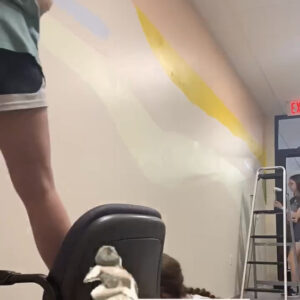
Due to a recent round of budget cuts, Oklahoma Christian University’s College of Liberal Arts made the decision to eliminate their photography program.
Across the entire university, an 8.7 percent decrease in overall budget was needed. However, the university called for strategic, as opposed to overall, budget cuts. Each department would not be hit equally.
David Lowry, dean of the College of Liberal Arts, was informed that his department would be required to decrease their budget by four percent, or approximately $150,000.
Lowry began taking measures to cut the budgets of his departments.
“We went through all the budget lines and we looked for places where we didn’t use all the money the year before… we went and made the quick cuts by looking at that,” Lowry said.
Lowry’s next step was to consult with the chairs of each department involved in the college of liberal arts to find out where to make the cuts. The Department of Art and Design’s chair, David Crismon, was a part of this group.
Crismon and his team of faculty were told to cut $45,000 out of their budget. This is when the decision to dissolve the photography degree was made, eliminating five classes from the current curriculum.
“We hate to cut anything, but if we don’t, we wind up charging students more tuition and we continue running in an inefficient manner,” Lowry said. “And we know our students don’t want that… because they pay a lot for their education as it is, so they depend upon us to say ‘this just isn’t working like it should so we’ll do that.’”
Lowry said the cut was not due to disappointment in the majors themselves.
“It is not because we are disappointed or unhappy with that degree, it is not because they weren’t doing a fantastic job,” Lowry said.
According to Lowry, the photography major was evaluated due to its lack of full-time faculty.
“All of the degrees offered in art actually have a professor that has a degree in the area, but we did not have a professor who could be the champion or the leader of the degree… we were actually offering a degree that was run completely by adjuncts,” Lowry said.
Lora Arnold, senior photography major, said although she will be able to complete her degree, there are those further behind that will not have that opportunity.
“When [Crismon] told me about it I was really upset because I am almost done… But then, knowing people that are just getting into it and love it and knowing that they’re going to have to change… it kind of makes me hurt that they won’t be able to finish,” Arnold said.
Because Arnold is so far along in her degree program, the College of Liberal Arts will assist her in finishing her degree, as they will with any upperclassmen in the major.
“We’re committed to helping people teach out,” Lowry said “Those who are just starting their degrees, on the front end… they’ll have to find a different major. For those that are well into the degree, close to graduation, we’ve got to help them get through and take care of them.”
Arnold, only a semester behind, will take substation courses, classes at local colleges or internships to make up for any classes she may miss due to the cuts. However, Arnold said she appreciated the dynamic of her classes at Oklahoma Christian.
“What I really liked about my photography classes is that we get to go out and not just stay at OC, but go out and take pictures downtown, Bricktown, Guthrie, Lake Hefner, Lake Arcadia… go out and experience Oklahoma territory and take pictures and get that kind of experience,” Arnold said.
Oklahoma Christian’s photography degree was a fairly recent addition to the art and design department. Based on student inquiries and interest in a photography major, as well as the reception of previous photography courses, the College of Liberal Arts believed the degree would be well received.
However, the degree did not grow as rapidly as expected. According to Lowry, the degree currently has approximately eight declared majors.
“Had the degree been really successful, we probably would have been able to hire people for that degree, that would be the ideal way to build it… since it wasn’t going in that direction, it was best to just stop now,” Lowry said.
When looking at the budget with his fellow faculty members, Crismon said they attempted to make the least intrusive cuts.
“Our question was ‘how do we do this in the least invasive way possible?’ and that’s what we came up with… photography,” Crismon said. “I proposed that degree and I was overseeing that degree… it ran on a shoestring budget… at the same time, if you were to compare the degrees in the department, it had the least amount of majors, so that’s where we had to turn.”
With the photography degree deletion, the option to focus on photography as a Communication Design major is no longer an option. However, majors in the department will still be required to take a photography class.
According to Crismon, at least one photography class will remain, most likely a condensed version of the five classes previously removed.
Even after the photography major was cut, there was still a final number the art department had to delete from their budget.
“We took the existing photography courses and collapsed into one course, that’s our proposal… with that you are saving those adjunct salaries for some of those classes,” Crismon said. “It was some money, but it wasn’t in the scheme of things a lot of money.”
With the degree, the department’s long-standing printmaking class was also eliminated.
“We don’t like that, that’s been taught by the university for 25 years,” Crismon said. “But we don’t have adequate space to offer that course in an effective or safe manner… it’s not that we don’t want to offer it, we think it’s integral… but that took a hit.”
Some faculty members took reduced salaries as well as a gallery budget taking a 26 percent reduction. The general supply budget was also cut.
“The faculty, and certainly the chairs of the department of liberal arts were able to constructively negotiate a compromise… given the situation,” Crismon said. “Likewise, I think at the department level… the four of us got together and rolled up our sleeves and got down to work and everyone was willing to give up some things, some very tangible things, in order for this to go on in the least painful way possible.”
The numbers of some core curriculum classes in the art department were reduced. Technology for graphics went from six sections to three sections, figure drawing went from three to two and fundamentals of drawing went from five to three.
Crismon said that though the reduction in class options will hurt the class sizes and ability to effectively help students, it was the best option in order to run as usual.
“That was our objective: number one that the students know that it wasn’t four faculty members sitting around trying to mess with things. And number two -given the mandate that we were given – what was the best, safest, most efficient, least invasive way to rearrange this deck of cards so you guys were not taking a hit in terms of quality,” Crismon said.
Despite the many cuts Crismon and Lowry had to make, Crismon said he remembers he is not the only one making cuts and he still tries to remain positive.
“A lot of people on campus are having to make the same sacrifices and the same decisions… it was handled quite well, considering,” Crismon said. “It’s a positive note for an otherwise negative situation. “
Lowry said though budget cuts can lead to unfortunate situations, they still have a place at Oklahoma Christian.
“Budget cuts are just awful experiences to go through, but they also provide a bit of clarity,” Lowry said. “When you need more resources than you have… it causes you to say ‘ok, what are we doing really well that we could do better, if we weren’t spending our money out in other areas that aren’t doing so well.’ And that really becomes the question that we always ought to be asking ourselves.”














Be First to Comment